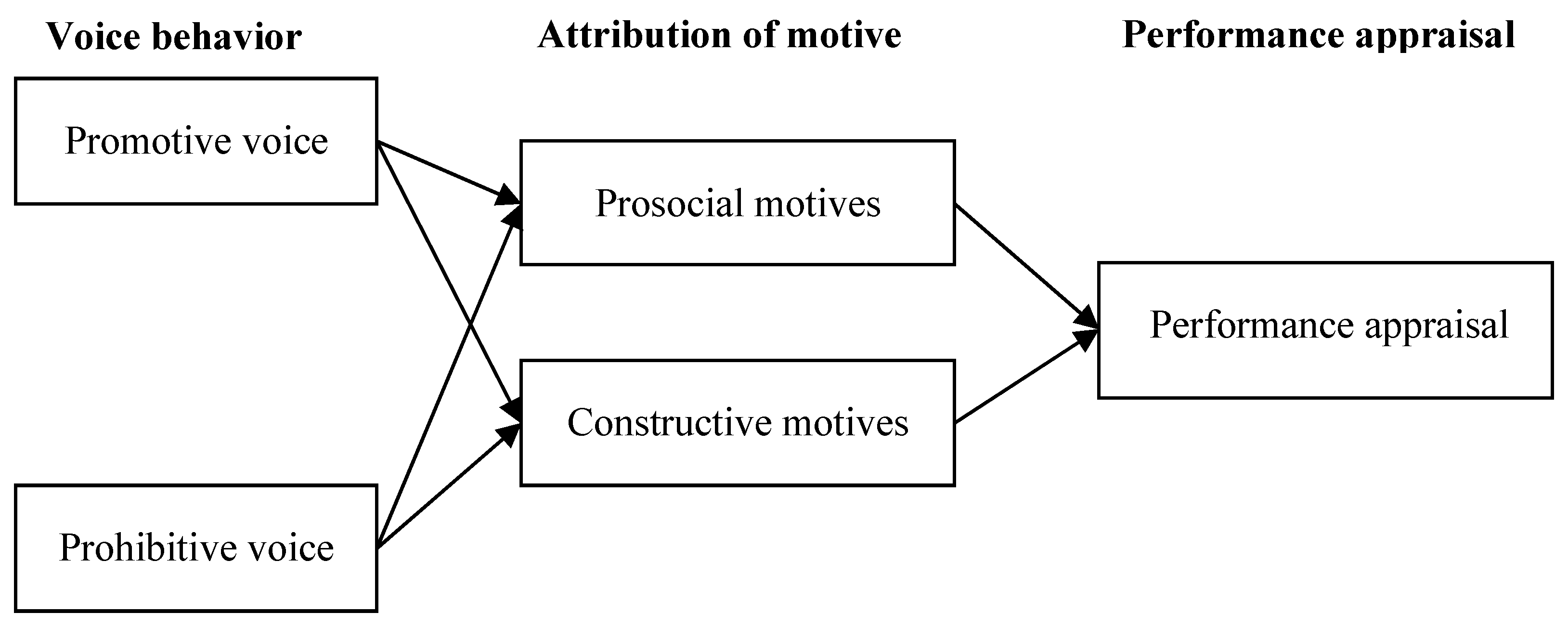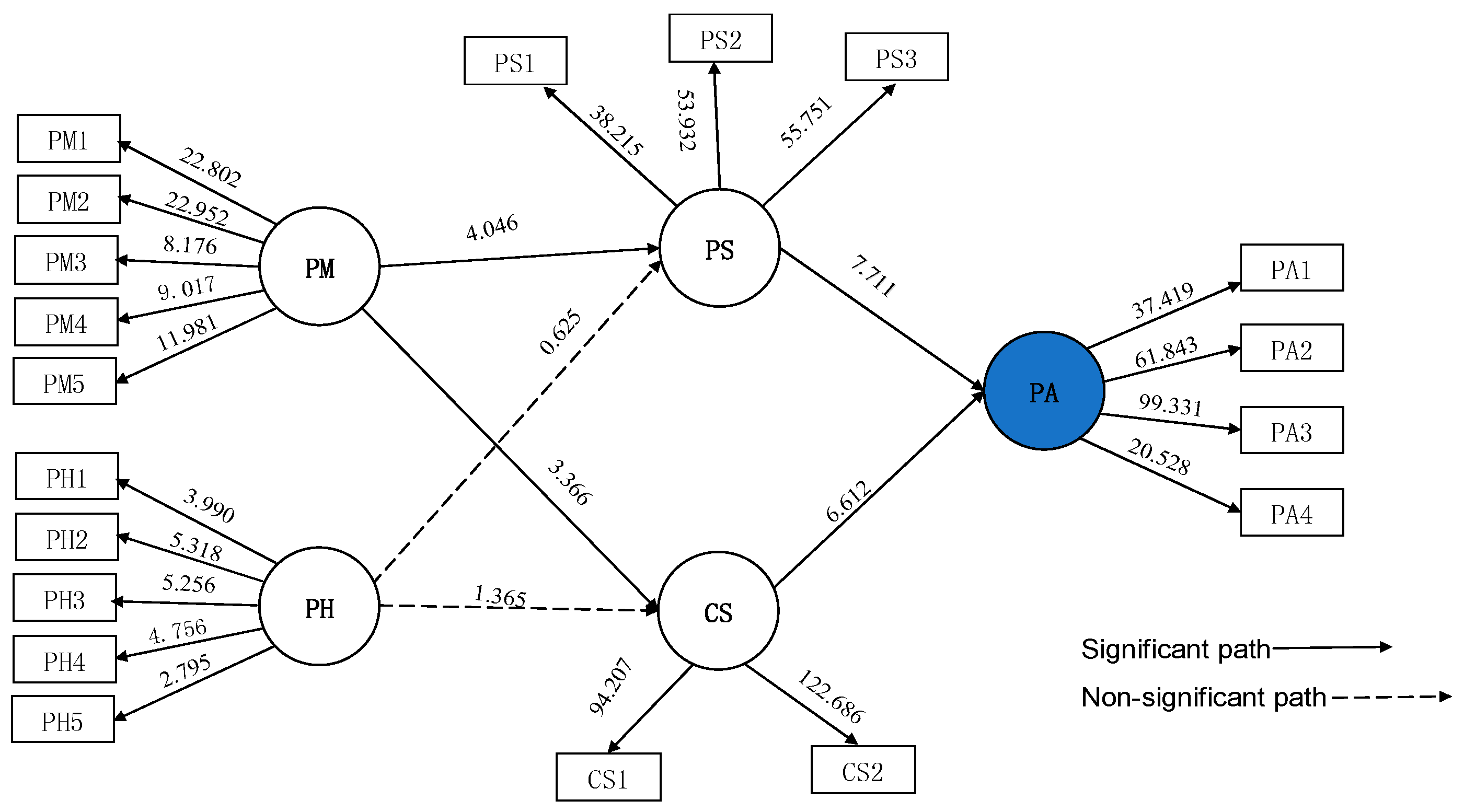1. Introduction
With market competitiveness growing due to deregulation policy and increased business entrepreneurship in recent years, firms’ external environments have become more and more uncertain, thereby increasing the difficulty of management decision-making and risking the sustainability of the organization. A sustainable organization is viewed as more than just enduring but an organization where employees are actively involved in a continuous process of change; one in which the culture of the organization embraces different ways of working, relating, and thinking to remain viable [
1].
As an important information source for managerial decision-making in an environment of change, employee voice has the potential to contribute to organizational sustainability. Employee voice refers to the expression of change-oriented ideas, opinions, and suggestions to a specific target within the organization with the intent to improve the situation at work [
2,
3]. First line employees learn the needs of customers and suppliers, and when these employees use voice to communicate their knowledge of these stakeholders, voice plays an important role in organizational decision-making. Bashur & Oc’s (2014) study identifies the value of employee opinion in better decision making, lower turnover, and innovation in organizations [
3]. The absence of employee voice (i.e., silence), may be a sign that the organization lacks morale and the opportunity to improve is at risk [
4].
However, employee voice often questions the current policies and challenges the authority of decision makers. Therefore, employee voice could potentially damage interpersonal relationships, especially the relationship between a supervisor and an employee [
2,
5,
6,
7]. This raises an important and interesting question: how does the employee voice influence employee performance appraisal? The impact of employee voice on employee performance evaluation not only affects employee career development, but also the organization’s ability to deliver value and assure survival of all stakeholders, including the employees since the employee performance ratings ultimately affect the employees voice behaviors [
8].
Although the contributions of employee voice to group or organizational performance are widely recognized, it is still not clear whether and how this recognition is reflected in employee performance evaluations [
7]. In existing studies based on the social exchange theory [
9], a typical viewpoint holds that because voice behavior can improve the team or organizational performance, supervisors should give a positive performance appraisal (i.e., high ratings) to employees who are willing to share their knowledge, ideas, and opinions for managerial problem solving. This viewpoint is supported by empirical studies which found that voice behavior is positively associated with the evaluation of employee performance [
3,
8,
10,
11]. In the existing literature, the voice is viewed as an aspect of citizenship behavior involving innovative suggestions that contribute toward changing existing practices and leading to improvements [
12]. However, others have argued that voice can have unfavorable impacts on employees due to its challengeable nature. This viewpoint is also supported by some relevant findings that employee voice has a negative effect on employee career success, such as salary progression and promotion, implying that employee voice is negatively associated with employee performance ratings [
6,
13]. This negative relationship is more likely to occur in societies with higher power distance (e.g., the east Asian region) [
14].
To integrate these competing perspectives and resolve empirical puzzles, researchers have developed varying theoretical frameworks. Burris (2012) distinguished the types of employee voice, and found that individuals who use challenging voice are less recognized than those who engage in supportive voice, and their ideas are less endorsed [
15]. Moreover, Burris et al. (2013) emphasized the role of agreement and disagreement around voice between employees and supervisors [
16]. They proposed that agreement around voice between employees and supervisors has a favorable impact on employees, and disagreement around voice leads to two different outcomes; employees overestimating (underestimating) their voice relative to their supervisors’ perspective will result in negative (positive) outcomes.
This paper aims to investigate the impact of employee voice on performance appraisal from the perspective of supervisor’s attribution of the motives of employee voice. As the attribution theory suggests, when people observe certain behaviors, people tend to make dispositional attribution on behaviors that are under the control of the actors [
17,
18]. In recent years, the attribution perspective has been widely used in the studies on organizational behavior [
19,
20,
21]. The extant research has shown that performance appraisals are significantly influenced by the supervisor’s attribution of an employee’s motives behind certain behaviors [
22,
23], implying that when employees make suggestions and/or present new ideas, their motives will be perceived and attributed by supervisors, thereby influencing their performance appraisals.
By focusing on supervisor’s attribution of employee motives, this study contributes to the existing literature that deals with the relationship between employee voice and performance appraisal. In addition, most existing studies are conducted in the context of the Western culture and hence all of their conclusions may not hold in other cultures. Our study is based on a Chinese sample with substantial cultural differences. Specifically, our study is based on data collected from a state-owned Chinese enterprise, where the employees tend to remain silent due to the hierarchy structure. Accordingly, our study also aims to consider the external validity of existing results.
The remainder of this paper is organized as follows.
Section 2 develops the hypotheses on the linkage between employee voice, supervisor attribution and performance appraisal.
Section 3 introduces the methods and data. The empirical results are presented and discussed in
Section 4.
Section 5 concludes the paper.
5. Conclusions and Implications
5.1. Conclusions
By focusing on supervisor’s attribution of employee motives, this paper examines the impact of the employee voice on performance appraisal. We test our model’s hypotheses with 273 dyads of supervisor-employee questionnaires administered on a branch of a state-owned enterprise in China. Empirical results based on partial least squares (PLS) show that promotive voice has a significant and positive effect on supervisor’s attribution of prosocial motives and constructive motives. The promotive voice, which focuses on a future-oriented ideal state and aims to increase the “process gain” by making things better, is often viewed as an expression of “what could be” [
37]. Promotive voice is more likely to be attributed to altruistic motives. In contrast, prohibitive voice is not significantly associated with supervisor’s attribution of prosocial and constructive motives. The prohibitive voice, which concentrates on the past or present-oriented factors that are harmful to organizations and attempts to prevent or reduce the “process losses”, is often viewed as an expression of “what should be”. Prohibitive voice is less likely to be attributed to altruistic motives. This suggests that supervisors are also less likely to view prohibitive voice as contributing to the sustainability of the organization.
Supervisor’s attribution of the prosocial motives and constructive motives for voice behavior is significantly associated with the employee performance appraisal in a positive direction. This suggests that, owing to the challengeable nature of the voice behaviors, supervisor’s attribution of the voice motives has a significant impact on employee performance appraisal. Moreover, the employee voice with a prosocial motive can contribute to interpersonal harmony within the organization. The employee voice with a constructive motive can make organizations work more effectively and operate in a future oriented manner. As a result, the supervisors are more likely to reward voice behaviors with prosocial motives and constructive motives.
Supervisor’s attribution of prosocial motives and constructive motives lead to full mediation of the relationship between promotive voice and employee performance appraisal. This means that promotive voice fully affects employee performance ratings through supervisor perception of the prosocial motives and constructive motives. In addition, the supervisor’s attribution of the prosocial motives and constructive motives has no mediation effect on the relationship between prohibitive voice and employee performance ratings due to the traits of prohibitive voice.
5.2. Contribution to Theory Building
Whether and how the employee voice behavior affects their performance appraisal ratings remains a debatable issue. Recent studies have developed new theories to integrate the competing perspectives and resolve the empirical puzzles [
15,
16]. Using the attribution theory, we contribute to the existing literature by considering the supervisor attribution of the voice motives. Our analysis suggests that owing to the difficulties in identifying the true motives of the employee voice behaviors, the supervisor’s attribution of the motives affects the relationship between the employee voice and performance appraisal. Specifically, only the voice behaviors attributed to the prosocial and constructive motives can have a positive impact on the performance rating of the employees.
To identify how supervisors attribute the motives behind the employee voice behaviors differently, we disaggregated the employee voice into a promotive and prohibitive voice. We argue that compared with the promotive voice, prohibitive voice is more challengeable in content and aggressive in tone. Therefore, it is less likely to be attributed to the prosocial motives and constructive motives.
Finally, it is worth mentioning that previous research on this issue is mainly conducted in the context of the Western culture. Since the cognition of the individuals is undoubtedly affected by their cultural traits and the Chinese cultural is very different from the Western culture, this study also deals with external validity of the existing results.
5.3. Practical Implications
The empirical analysis presented in this study shows that different types of employee voice may have different impacts on employee performance ratings due to supervisor’s attribution of voice motives. If the employees plan to change the status quo, they had better choose the promotive voice, which is more likely to be attributed to altruistic motives and also viewed as supporting the long term organizational sustainability by the supervisors. Of course, this does not mean that employees cannot voice in a prohibitive manner. If employees tend to choose prohibitive voice, they should try to make their motives prosocial and constructive in some manner, including clear framing, factual documentation and appropriate timing [
25]. This strategy can help the supervisors to better understand the true motives of the employees. Additionally, employees choosing prohibitive voice should be trustworthy and professional, so that the motives behind their voice can be more clearly identified by the supervisors.
The findings of this study have important implications for the attitude of the supervisors (especially, the attitude towards the prohibitive voice of the employees). To create a good environment for employee voice and consistently obtain valuable information for decision making and organizational sustainability, supervisors should appropriately attribute the motives of employee voice behaviors. Regardless of whether employees offer suggestions in a promotive or prohibitive manner, if their motives are indeed prosocial or constructive, the supervisors should provide a positive and motivating performance appraisal to the employees.
5.4. Limitation and Future Research
The search reported in this study is a part of a small-scale research project, where the sample is drawn from a branch of a typical SOE. Future research should explore whether the results are applicable to non-SOEs. The concerns of the supervisors vary considerably across organizations and hence they may attribute the employee voice motives differently. Future research should compare the results of data collected from private and foreign-owned firms. Moreover, when examining the impact of different types of voice on performance appraisal in future studies, some information on voice, such as the context, source, message, and timing, should be controlled since these factors have been found to have some impact on supervisor’s attribution of voice motives [
11]. The future research may also consider the moderating effect of variables such as the leadership style, organization climate, on the relationship between employee voice, supervisor attribution and performance appraisal. In summary, while there is no evidence of significant omitted variable bias in our study, it is highly desirable to use a larger model to re-examine the impact of employee voice on performance evaluation in China.







